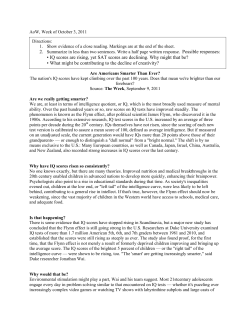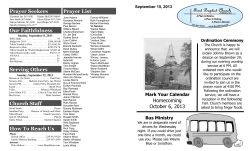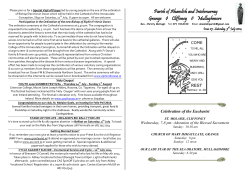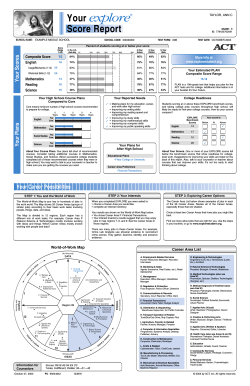
Package ‘vegan3d’ October 7, 2014
Package ‘vegan3d’ October 7, 2014 Title Static and dynamic 3D plots for vegan package Version 0.65-0 Date 2014-10-06 Depends vegan (>= 2.0-10) Imports rgl, scatterplot3d Description Static and dynamic 3D plots to be used with ordination results and in diversity analysis, especially with the vegan package License GPL-2 BugReports https://github.com/vegandevs/vegan3d/issues URL https://github.com/vegandevs/vegan3d Author Jari Oksanen [aut, cre],Roeland Kindt [aut],Gavin L. Simpson [aut] Maintainer Jari Oksanen <jari.oksanen@oulu.fi> NeedsCompilation no Repository CRAN Date/Publication 2014-10-07 10:53:45 R topics documented: ordiplot3d . . . ordirgl . . . . . rgl.isomap . . . rgl.renyiaccum . . . . . . . . . . . . . . . . . . . . . . . . . . . . . . . . . . . . . . . . . . . . . . . . . . . . . . . . Index . . . . . . . . . . . . . . . . . . . . . . . . . . . . . . . . . . . . . . . . . . . . . . . . . . . . . . . . . . . . . . . . . . . . . . . . . . . . . . . . . . . . . . . . . . . . . . . . . . . . 2 4 6 7 9 1 2 ordiplot3d ordiplot3d Three-Dimensional Ordination Graphics Description Function ordiplot3d displays three-dimensional ordination graphics using scatterplot3d. Function works with all ordination results form vegan and all ordination results known by scores function. Usage ordiplot3d(object, display = "sites", choices = 1:3, ax.col = 2, arr.len = 0.1, arr.col = 4, envfit, xlab, ylab, zlab, ...) Arguments object An ordination result or any object known by scores. display Display "sites" or "species" or other ordination object recognized by scores. choices Selected three axes. ax.col Axis colour (concerns only the crossed axes through the origin). arr.len ’Length’ (width) of arrow head passed to arrows function. arr.col Colour of biplot arrows and centroids of environmental variables. envfit Fitted environmental variables from envfit displayed in the graph. xlab, ylab, zlab Axis labels passed to scatterplot3d. If missing, labels are taken from the ordination result. Set to NA to suppress labels. ... Other parameters passed to graphical functions. Details Function ordiplot3d plots static three-dimensional scatter diagrams using scatterplot3d. Function uses most default settings of underlying graphical functions, and you must consult their help pages to change graphics to suit your taste (see scatterplot3d). Function will display only one selected set of scores, typically either "sites" or "species", but for instance cca also has "lc" scores. In constrained ordination (cca, rda, capscale), biplot arrows and centroids are always displayed similarly as in two-dimensional plotting function plot.cca. Alternatively, it is possible to display fitted environmental vectors or class centroids from envfit. These are displayed similarly as the results of constrained ordination, and they can be shown only for non-constrained ordination. The user must remember to specify at least three axes in envfit if the results are used with these functions. Function ordiplot3d plots only points. However, it returns invisibly an object inheriting from ordiplot so that you can use identify.ordiplot to identify "points" or "arrows". The underlying scatterplot3d function accepts type = "n" so that only the axes, biplot arrows and centroids of environmental variables will be plotted, and the ordination scores can be added with ordiplot3d 3 text.ordiplot or points.ordiplot. Further, you can use any functions from the ordihull family with the invisible result of ordiplot3d, but you must remember to specify the display as "points" or "arrows". To change the viewing angle, orientation etc. you must see scatterplot3d. Only one kind of scores will be plotted. See Examples for plotting both species and site scores. Value Function ordiplot3d returns invisibly an object of class "ordiplot3d" inheriting from ordiplot. The return object will contain the coordinates projected onto two dimensions for points, and the projected coordinates of origin, and possibly the projected coordinates of the heads of arrows and centroids of environmental variables. Functions like identify.ordiplot, points.ordiplot, text.ordiplot can use this result, as well as ordihull and other functions documented with the latter. The result will also contain the object returned by scatterplot3d, including function xyz.convert which projects three-dimensional coordinates onto the plane used in the current plot (see Examples). In addition, there is a function envfit.convert that projects a three-dimensional envfit object to the current plot. Warning Function ordiplot3d is based on scatterplot3d which does not allow exactly setting equal aspect ratio for axes. The function tries to circumvent this by setting equal plotting ranges for all axes so that the plot should be a cube. Depending on the dimensions of plotting device, this may fail, and the user should verify that the axes are approximately equal. Please note that scatterplot3d sets internally some graphical parameters (such as mar for margins) and does not honour default settings. It is advisable to study carefully the documentation and examples of scatterplot3d. Author(s) Jari Oksanen See Also scatterplot3d, ordiplot, identify.ordiplot, text.ordiplot, points.ordiplot, ordihull, plot.cca, envfit. Examples ### Default 'ordiplot3d' data(dune, dune.env) ord <- cca(dune ~ A1 + Moisture, dune.env) ordiplot3d(ord) ### A boxed 'pin' version ordiplot3d(ord, type = "h") ### More user control pl <- ordiplot3d(ord, scaling = 3, angle=15, type="n") points(pl, "points", pch=16, col="red", cex = 0.7) ### identify(pl, "arrows", col="blue") would put labels in better positions text(pl, "arrows", col="blue", pos=3) text(pl, "centroids", col="blue", pos=1, cex = 1) 4 ordirgl ### Add species using xyz.convert function returned by ordiplot3d sp <- scores(ord, choices=1:3, display="species", scaling=3) text(pl$xyz.convert(sp), rownames(sp), cex=0.7, xpd=TRUE) ### Two ways of adding fitted variables to ordination plots ord <- cca(dune) ef <- envfit(ord ~ Moisture + A1, dune.env, choices = 1:3) ### 1. use argument 'envfit' ordiplot3d(ord, envfit = ef) ### 2. use returned envfit.convert function for better user control pl3 <- ordiplot3d(ord) plot(pl3$envfit.convert(ef), at = pl3$origin) ### envfit.convert() also handles different 'choices' of axes pl3 <- ordiplot3d(ord, choices = c(1,3,2)) plot(pl3$envfit.convert(ef), at = pl3$origin) ordirgl Three-Dimensional Dynamic Ordination Graphics Description Function ordirgl displays three-dimensional dynamic ordination graphs which can be rotated and zoomed into using rgl package. Function workw with all ordination results form vegan and all ordination results known by scores function. Usage ordirgl(object, display = "sites", choices = 1:3, type = "p", ax.col = "red", arr.col = "yellow", text, envfit, ...) orglpoints(object, display = "sites", choices = 1:3, ...) orgltext(object, text, display = "sites", choices = 1:3, justify = "center", adj = 0.5, ...) orglsegments(object, groups, display = "sites", choices = 1:3, ...) orglspider(object, groups, display = "sites", w = weights(object, display), choices = 1:3, ...) Arguments object An ordination result or any object known by scores. display Display "sites" or "species" or other ordination object recognized by scores. choices Selected three axes. type The type of plots: "p" for points or "t" for text labels. ax.col Axis colour (concerns only the crossed axes through the origin). arr.col Colour of biplot arrows and centroids of environmental variables. text Text to override the default with type = "t". envfit Fitted environmental variables from envfit displayed in the graph. ordirgl 5 justify, adj Text justification passed to rgl.texts. One of these is used depending on the version of rgl installed. groups Factor giving the groups for which the graphical item is drawn. w Weights used to find the average within group. Weights are used automatically for cca and decorana results, unless undone by the user. w=NULL sets equal weights to all points. ... Other parameters passed to graphical functions. Details Function ordirgl plots dynamic graphics using OpenGL with rgl. Function uses most default settings of underlying graphical functions, and you must consult their help pages to change graphics to suit your taste (rgl, rgl.points,rgl.texts). Functions will display only one selected set of scores, typically either "sites" or "species", but for instance cca also has "lc" scores. In constrained ordination (cca, rda, capscale), biplot arrows and centroids are always displayed similarly as in two-dimensional plotting function plot.cca. Alternatively, it is possible to display fitted environmental vectors or class centroids from envfit in both graphs. These are displayed similarly as the results of constrained ordination, and they can be shown only for non-constrained ordination. The user must remember to specify at least three axes in envfit if the results are used with these functions. Function ordigl makes a dynamic three-dimensional graph that can be rotated with mouse, and zoomed into with mouse buttons or wheel (but Mac users with one-button mouse should see rgl.viewpoint, or try ctrl-button). MacOS X users must start X11 before calling rgl commands. Function ordirgl uses default settings, and you should consult the underlying functions rgl.points, rgl.texts to see how to control the graphics. Function ordirgl always cleans its graphic window before drawing. Functions orglpoints adds points and orgltext adds text to existing ordirgl windows. In addition, function orglsegments combines points within "groups" with line segments similarly as ordisegments. Function orglspider works similarly as ordispider: it connects points to their weighted centroid within "groups", and in constrained ordination it can connect "wa" or weighted averages scores to corresponding "lc" or linear combination scores if "groups" is missing. In addition, basic rgl functions rgl.points, rgl.texts, rgl.lines and many others can be used. Value Function ordirgl returns nothing. Warning Function ordirgl uses OpenGL package rgl which may not be functional in all platforms, and can crash R in some: use save.image before trying ordirgl. Mac users must start X11 (and first install X11 and some other libraries) before being able to use rgl. It seems that rgl.texts does not always position the text like supposed, and it may be safe to verify text location with corresponding points. Note The function was originally written for rgl version 0.64-0, but its user interface was upgraded to 0.65-0. However, more modern features of rgl are not used. 6 rgl.isomap Author(s) Jari Oksanen See Also rgl, rgl.points, rgl.texts, rgl.viewpoint, envfit. Examples ## Examples are not run, because they need user interaction. ## Not run: ordirgl(ord, size=2) ordirgl(ord, display = "species", type = "t") rgl.quit() ## End(Not run) rgl.isomap Dynamic 3D plot of isomap ordination. Description Function displays a dynamic 3D plot from isomap ordination. Usage rgl.isomap(x, web = "white", ...) Arguments x Result from isomap. web Colour of the web. ... Other parameters passed to ordirgl and scores. Details Function rgl.isomap displays dynamic 3D plots that can be rotated on the screen. The functions is based on ordirgl, but it adds the connecting lines. The function passes extra arguments to scores or ordirgl functions so that you can select axes, or define colours and sizes of points. Value Function returns nothing. Note This is a support function for isomap ordination in the vegan package. rgl.renyiaccum 7 Author(s) Jari Oksanen. See Also isomap, ordirgl, scores. Examples ## Not run: ## Function needs user interaction. data(BCI) dis <- vegdist(BCI) ord <- isomap(dis, k=5) rgl.isomap(ord, size=4, color="hotpink") ## End(Not run) rgl.renyiaccum Display dynamic perspective plot of Renyi diversity accumulation Description Function rgl.renyiaccum displays a dynamic 3D plot of the result of renyiaccum function in the vegan package. Function persp.renyiaccum (in vegan) produces similar static plots. Usage rgl.renyiaccum(x, rgl.height = 0.2, ...) Arguments x A renyiaccum result. rgl.height Vertical scaling of the plot. ... Other arguments passed to the function (ignored). Details This is a graphical support function to renyiaccum in vegan. Similar static plots can be produced by persp.renyiaccum. Value Function returns nothing. 8 rgl.renyiaccum Author(s) Roeland Kindt. See Also renyiaccum, persp.renyiaccum, rgl. Examples ## Not run: ## Needs user interaction. data(BCI) mod <- renyiaccum(BCI[1:12,]) persp(mod) rgl.renyiaccum(mod) ## End(Not run) Index rgl.lines, 5 rgl.points, 5, 6 rgl.renyiaccum, 7 rgl.texts, 5, 6 rgl.viewpoint, 5, 6 ∗Topic dynamic ordirgl, 4 rgl.isomap, 6 rgl.renyiaccum, 7 ∗Topic hplot ordiplot3d, 2 ordirgl, 4 rgl.isomap, 6 rgl.renyiaccum, 7 save.image, 5 scatterplot3d, 2, 3 scores, 2, 4–7 arrows, 2, 4 text.ordiplot, 3 capscale, 2, 5 cca, 2, 5 decorana, 5 envfit, 2–6 identify.ordiplot, 2, 3 isomap, 6, 7 ordihull, 3 ordiplot, 2, 3 ordiplot3d, 2 ordirgl, 4, 6, 7 ordisegments, 5 ordispider, 5 orglpoints (ordirgl), 4 orglsegments (ordirgl), 4 orglspider (ordirgl), 4 orgltext (ordirgl), 4 persp.renyiaccum, 7, 8 plot.cca, 2, 3, 5 points.ordiplot, 3 rda, 2, 5 renyiaccum, 7, 8 rgl, 4–6, 8 rgl.isomap, 6 9
© Copyright 2025











